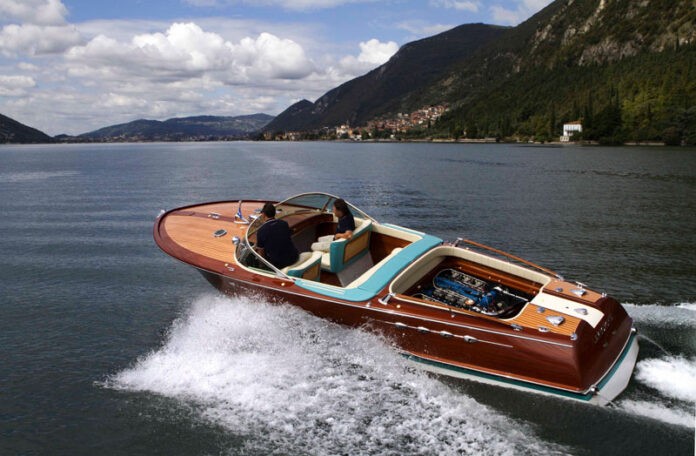The elegant mahogany design was an instant hit among CEOs, royalty and movie stars when it launched in 1962.
When Carlo Riva performed a Franken-boat surgery on one of his Tritone models in 1962, he had no idea that the gleaming new mahogany design would become the world’s most beloved powerboat. At the time, he was intent on reinventing the family brand, Riva, started by his great-grandfather Pietro in 1842 on Lake Iseo in Sarnico, Italy. Over the years, the yard had introduced many successful designs but needed a forward-looking model that reflected the glamour that was consuming postwar Italy.
Carlo originally wanted to call the new boat the Admiral but settled on a more futuristic name, Aquarama, after the trendy panoramic film technique Cinerama, which utilized three adjoining screens. The boat’s beautiful mahogany hull, with its sweeping, one-piece windshield and center sun pad, became a status symbol almost immediately after the Aquarama launched in 1962—no doubt helped by the fact that the boat was not only sexy but also fast and functional, powered by 185 hp Chris-Craft engines and able to hit a top speed of 45 mph.
The first Aquaramas were an instant hit among CEOs, royalty and movie stars, even priced as much as a Rolls-Royce Silver Cloud, the most expensive car in Italy at the time. Sophia Loren purchased hull number three, and soon Rex Harrison, King Hussein of Jordan and Brigitte Bardot and her third husband, the German baron and playboy Gunther Sachs, were all owners as well. By 1965, the Riva Aquarama was considered the world’s most desirable motorboat.

Its unmistakable shape became a centerpiece of Monaco’s harbor. “My father [Prince Rainier III] saw Mr. Riva as quite a businessman and engineer,” says Prince Albert II of Monaco. “And the Aquarama, of course, became the mythical symbol of the Riva adventure. It was so visible in Monaco [that] it became closely linked with our maritime presence.” The Monaco Yacht Club even created the Riva Aquarama Lounge, the only room named after a boat in the entire Lord Norman Foster–designed facility.
And it wasn’t just movie stars and royalty who gave the Aquarama its cachet. Carlo had accented the boat with references to the most expensive luxury cars of the day, including custom stainless-steel gauges, the steering wheel from the 1958 Chrysler 300, wicker tables that folded down behind the front seats and a nifty, spring-operated Bimini that shielded the cockpit from excessive sun and rain.
Fittingly, the Aquarama has always drawn more comparisons to couture and high culture than other machines. Carlo referred to the chrome fittings—including the bowsprit, nicknamed the crocodile’s grin for its distinctive shape—as the boat’s “jewelry,” while Augusto Savoldi, who began his apprenticeship at age 16 on the first Aquarama, recalls the master carpenters treating the original richly grained Honduran Cedar console like “a piece of art.” Carlo’s daughter Lia, meanwhile, remembers her father saying the engines’ melodic rumbling was “not noise; it’s music.” Perhaps the best barometer of the Aquarama’s iconic status is its consistently high resale value. Prices for historically correct restorations, depending on model and series, range between $400,000 and $800,000, with the record price, for the second-to-last-built Aquarama Special, standing at $1.15 million—still, perhaps, a small price to pay for history’s purest distillation of la dolce vita.






